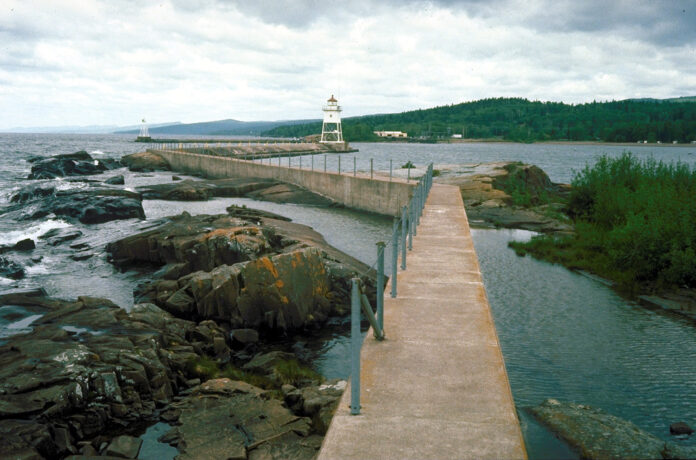By Steve Fernlund
A woman, part of a group of four people walking on the breakwall leading to the lighthouse in Grand Marais, was knocked off her feet and fell into Lake Superior. According to the Cook County Sheriff’s office, the incident took place at ap proximately 4:49 p.m. on Sunday, November 2.
Weather conditions made walking the breaking wall extremely dangerous. High winds (up to 40 to 50 mph gusts) and large waves were present.
The unnamed woman was quickly pulled from the water by members of her party, assisted by an individual who was fishing nearby, before first responders arrived. Deputy Will Sandstrom arrived and assist ed in bringing the woman to safe ground. According to a press release issued by Cook County Sheriff Pat Eliason, the woman was transported by ambulance to the hospital for medical care after complaining of a headache and weakness.
In his statement, Eliason said, “The heroic actions of the people with the victim were instrumental in avoiding a tragedy in this situation… Although Lake Superior is a tremendous sight when the winds are blowing strong, the lake is not forgiving when you make a mistake.”
Local photographer David John son was on the opposite side of the harbor entrance when he witnessed people walking on the breakwall. He wrote on a Facebook post where he shared some pictures he took that afternoon, “A few shots from the big wave encounter some tourists had, one swept off, I would see them disappear when a big wave went over them, to my surprise they made it through many big waves, lucky people.”
It is of utmost importance to heed safety warnings and stay off Lake Superior breakwalls when winds exceed 40 MPH. These structures, due to a combination of extreme hazards, are unpredictable and highly dangerous. Large waves can easily knock you into the water, and strong currents can make it impossible to reach safety.
Waves generated by winds exceeding 40 MPH are large, rapidly breaking, and powerful. Even a 3-foot wave on the Great Lakes has enough force to knock down a full-grown adult. When water hits a solid, stationary structure, such as a breakwall, its force is magnified. The breakwall surface is constantly wet, either from crashing waves or spray. This makes the rocks or concrete incredibly slick when wet, resulting in unstable footing. Strong winds can push water toward the shore, causing large, unpredictable ‘rogue waves’-waves that are significantly larger than the others and can crash over the entire structure, sweeping people off instantly.
Lake Superior water is notoriously cold. Falling into its water triggers an immediate physical response within the first minute: an involuntary gasp, hyperventilation, and increased heart rate. This can lead to the inhalation of water and immediate drowning, regardless of swimming ability.
After the initial shock, you lose dexterity and muscle control, making it impossible to swim to a ladder or grab onto the slippery rocks for rescue.
When winds exceed 40 MPH, the breakwall transforms from a viewing platform into a highly hazardous zone where the lake’s power is concentrated and magnified. It’s crucial to always respect the power of Lake Superior and avoid taking unnecessary risks, especially during adverse weather conditions.



